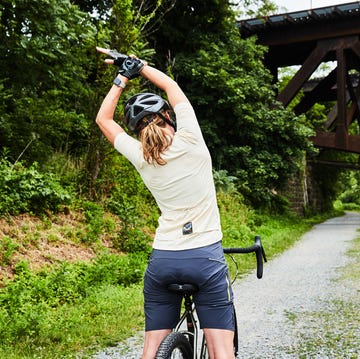Meniscus tears are one of the most common sports-related injuries, according to an article published in Cureus in 2022. This injury to the knee cartilage can be painful, but there is a silver lining: You may be able to continue cycling while you heal. In fact, some doctors and physical therapists recommend cycling as part of the rehab and recovery process.
Before you hop in the saddle, though, you should understand the meniscus, a crucial part of the knee joint, including what it does, what commonly causes injuries, and how cycling can best help your recovery.
First, Understand Your Meniscus and How it Tears
The meniscus is a piece of C-shaped cartilage in the knee joint that sits between the femur (thigh bone) and the tibia (shin bone). You have two menisci—a lateral and a medial—in each knee and both act as shock absorbers.
“[The meniscus] helps take some pressure off of the joint itself, especially when we are running and walking. It also helps the knee joint glide better when you’re bending and extending your knee,” Jessie Duppler, P.T., D.P.T., creator of the Chain Reaction Strength Revolution program for cyclists, tells Bicycling.
According to the Cureus article, athletes who play sports in which they plant their foot and change directions or move sideways (like in soccer, basketball, and tennis), are most susceptible to acute meniscus injuries, while older adults are more likely to have degenerative changes in their cartilage.
While acute tears are less common among cyclists, “every once in a while, someone has trouble getting out of their clipless pedals, and they’re twisting their ankle in order to release their shoe. Sometimes that doesn’t go well, and they’ll tear their meniscus just from doing that,” Kevin Stone, M.D., an orthopaedic surgeon at The Stone Clinic and chairman of the Stone Research Foundation tells Bicycling.
There’s also the hazard of everyday movements. “Someone can tear their meniscus getting out of a car,” Stone adds.
If a meniscus tear is due to a sudden injury, you’ll likely know something’s wrong immediately. People often hear a popping or snapping sound as they twist their knee joint, which quickly swells. Then, bending and extending the knee is painful.
As for degenerative meniscus tears, which occur over time, they can sometimes be due to arthritis, Duppler says. As people age, their joint surfaces become rough, and that can irritate the meniscus.
Because there are different degrees and types of meniscus tears, doctors and physical therapists use a cluster of in-office tests to determine the type and severity. But the only way to generate a completely accurate diagnosis is with MRI imaging.
Meniscus Tear Treatment and Recovery
Surgery for a meniscus tear is very common, but it depends on a number of factors, including “the degree of the tear, if there are any other ligaments or connective tissue involved, and where in the meniscus the tear is,” Duppler says. “Those things impact treatment.”
However, some research indicates that physical therapy, including joint mobilization and soft tissue work to the muscles around the knee, can be just as effective as surgery, over time. “If the knee joint is stable, and the meniscus is stable on exam, and the MRI shows an incomplete tear, that’s one that might heal on its own,” Stone says.
One randomized clinical trial published in 2022 of those who had degenerative meniscus tears compared the results of exercise-based physical therapy with the results of those who had arthroscopic surgery, in which parts of the damaged meniscus is removed or trimmed. The results were comparable, and the study authors concluded physical therapy was the preferred treatment for degenerative tears.
However, there are some downsides to opting out of surgery, says Stone. Sometimes, without surgery, the rotation of the knee can cause a tear to worsen. “This is where you start to wear away at the bearing surface of the joint that the meniscus protects,” Stone says. The sooner a tear is repaired, the less likely the patient is to develop post-traumatic arthritis, he explains.
How Cycling Can Help With a Meniscus Tear
Anyone with knee pain should see a doctor and get rehabilitation advice, but movement is typically good for the healing process, especially if the tear is degenerative or if a patient has meniscus surgery and then is ready to start the recovery process.
That’s because joints contain synovial fluid, a lubricating liquid that delivers nutrition to the joint. “When we move, it basically bathes the joint and the meniscus and all the surrounding structures in what’s essentially the juice of the joint,” Duppler says.
On the other hand, if your favorite sport is high impact, such as running, then the risks may outweigh the benefits of the motion. Fortunately, cycling is a great option. Riding a bike may help those healing with a meniscus tear because it takes weight-bearing movement out of the equation. “There’s a lot less pressure and a lot less force going through the knee joint,” Duppler says.
The knee also undergoes less extension when cycling than it does when running or walking, and you can usually go through the full range of motion of a pedal stroke without causing further damage.
Another benefit of cycling is that you can amp up the intensity of a workout by adding resistance or an incline without increasing impact. “You can get a good, hard workout with a cycling regimen, which you might not be able to do if you were trying to protect your knee in another type of exercise that is more loading,” Stone says.
You can also start riding (at least with one leg) as early as the first day of rehab, which Stone recommends for patients who have undergone repair surgery. “They put their injured knee on a stool, and they spin with their well leg,” he says. “The reason is you increase your blood flow, your testosterone, your adrenaline, and all your hormones. You also gain a better mindset, which is a big player in the healing process.”
How to Cycle With a Meniscus Tear
While cycling is often considered a go-to exercise for active people with meniscus tears, it’s not universally safe for everyone or without its own risks. Always check with your doctor for clearance to get on the bike, and keep the following points in mind:
Check Your Bike Fit
Especially when you are injured, bike fit is key. “Make sure you’re not bending the knee too much at the top of your pedal stroke, and you don’t have to reach too far down to pedal at the bottom of the pedal stroke,” Duppler says. “You want to keep within a range that doesn’t overly stress the knee.”
Start With Shorter Workouts
While your meniscus is healing, only ride for 10 or 15 minutes (or whatever your doctor recommends) when you first start out on the bike. “If it feels good with your limited time, add an extra five minutes on each time you ride,” Duppler says.
Don’t get overconfident and start with 15 minutes then increase to 30 minutes if one 15-minute ride felt good. Give your body and knee a chance to ease back into cycling.
Don’t Ignore Pain
Often, cyclists push through pain, but when pedaling hurts, check in specialist. “Gentle, pain-free movement is really the goal,” Duppler says.
If you feel pain after your ride, it could mean that you went too hard. In this case, Duppler recommends significantly dialing back your intensity and your workout duration the next time you get on the bike.
“Then, you can slowly start to build from there. It’s always easier to add on more time or effort than it is to have to significantly decrease both because you did too much and your knee is bothered by it,” she says.
Get Accurate, Up-to-Date Assessments
The condition of your joints will change over time, and as you recover, you may need a new treatment plan to address the original diagnosis. Having a doctor check your progress will not only help you determine how much you should ride, but also get a prescription for other exercises that may strengthen the muscles around the knee.
In other words, regularly check in with your doctor or physical therapist so you keep progressing.
Consider Riding Inside
While being outside has many mental health benefits, pedaling on a spin bike or trainer allows you to control the environment. Being on the open road or trail introduces unpredictability, such as uneven terrain, obstacles, and inclement weather. Also, if your knee starts to bother you, the last place you want to be is far from home.
“However, if riding inside drives you nuts, just take precautions,” Duppler says. “Carry your cell phone, make sure you’re easily seen, make sure you have stuff for a flat. All of the stuff to make sure you’re best prepared for any contingency when riding outside.”
If possible, pick an easy, familiar route too, especially your first few times back out there.
Switch to Flat Pedals
During recovery may not be the time to clip in. “It may be a good idea to switch to flat pedals at first,” Duppler says. “Flat pedals make it easier to put a foot down, and they decrease the amount of clipping in and clipping out,” a motion that places rotational force on the knee. This force can be tough on the meniscus and potentially cause more pain.
Take a Seat
Depending on the specifics of your injury and where you are in your recovery, standing in the saddle may put too much pressure on a healing meniscus. “If standing causes pain, or you notice a significant increase in pain after riding, don’t stand and just keep it to a resistance you can push while seated,” Duppler says.













